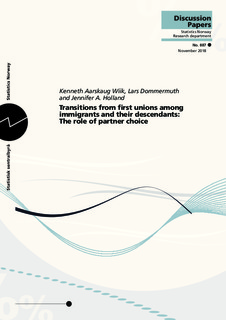Transitions from first unions among immigrants and their descendants. The role of partner choice
Working paper
Published version
Permanent lenke
http://hdl.handle.net/11250/2627542Utgivelsesdato
2018-11Metadata
Vis full innførselSamlinger
- Discussion Papers [1003]
Sammendrag
The family life courses of immigrants and their descendants, particularly intermarriage and the timing of marriage and childbearing, have been widely studied as indicators of societal integration. But largely absent are investigations into the role of cohabitation in the family lives of these subpopulations. Choosing cohabitation as first union may, for instance, signal secularization and less social control. Using Norwegian register data on all first co-residential unions entered 2006-2015 among individuals born 1980 or later (N=218,833 unions, 80.5% cohabitations), we consider associations between partner choice and subsequent partnership transitions. Around half of first unions including second-generation individuals were cohabitations, among which 88% were exogamous (i.e., partners originating from different countries or with a majority partner). These exogamous cohabiting couples were more dissolution-prone and less likely to marry than endogamous immigrant and second-generation cohabiting couples. Among second-generation couples who married directly, on the other hand, 79% were endogamous. These marriages were less likely to divorce than their first-generation counterparts.
